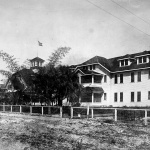The year was 1923. There was not a single mile of paved road in all of Naples, Florida. In fact, there wasn’t a single mile of concrete road in the entire county. The modern reader may think that something like this was commonplace in the US that far back in time but actually the urban environment of 1923 in the huge American cities looked much closer to what we have now.
At the beginning of the 20th century, engineers of that time have discovered a steel-making process that would make steel much more durable and be manufactured at a much faster rate. As a result, skyscrapers dominated Manhattan and automobiles were made accessible to more people than ever before. This created a sort of look and feel that we get when we are in our big cities of today. This is also why, at 1923, a county with no paved road seemed as unimaginable today as it was then.
But then again, the entire Collier county was still mostly in development phase at this time. And all big things start somewhere. And to Naples, Florida area this somewhere is in the southernmost 275 miles of U.S. Highway 41 from Florida State Road 60 in Tampa to US 1 in Miami. It was a daunting task and met many hurdles and obstacles but the pioneering men such as Baron Collier and David Graham Copeland would not back down against this challenge.
A time came to pass when the Florida state ran out of money for a major highway road construction that would connect Naples and Dade County. Collier, then, stepped in and offered to help fund the construction under the condition that his property holdings, already sizable at that time, should obtain county status. The state agreed and Collier lived up to his word. Today this highway is named the Tamiami Trail which covers 275 miles of concrete and made the transportation of trade and goods as well as citizens much more convenient and thus became vital to the region’s progress.
Collier then looked for a man he can trust. This man came by the name of, David Graham Copeland, a retired naval officer and engineer. Copeland was presented what would appear to be the insurmountable task of building a town and modern highway in the Florida wilderness. Though tough, he managed to get through with it and transformed the Everglades (which recently became the new county seat at that time) to a communications and supply center that was at par with the standards of its time. This paved the way for surveyors, engineers and architects to build new docks, buildings, stores, schools, homes, streets, and mechanical shops. Because of the opening of the highway Collier was able to supply his own employees and the residents of the Everglades with water, electric power, regular mail delivery, railroad and steamship service, a weekly newspaper, telephones and even an electric trolley, turning this once empty, swampy area into an emerging corporate hub. And oh, Tamiami Trail and the U.S. Highway 41 is the same road, in case you’re wondering.
Then, the rest, they say, is history.










